Design
-
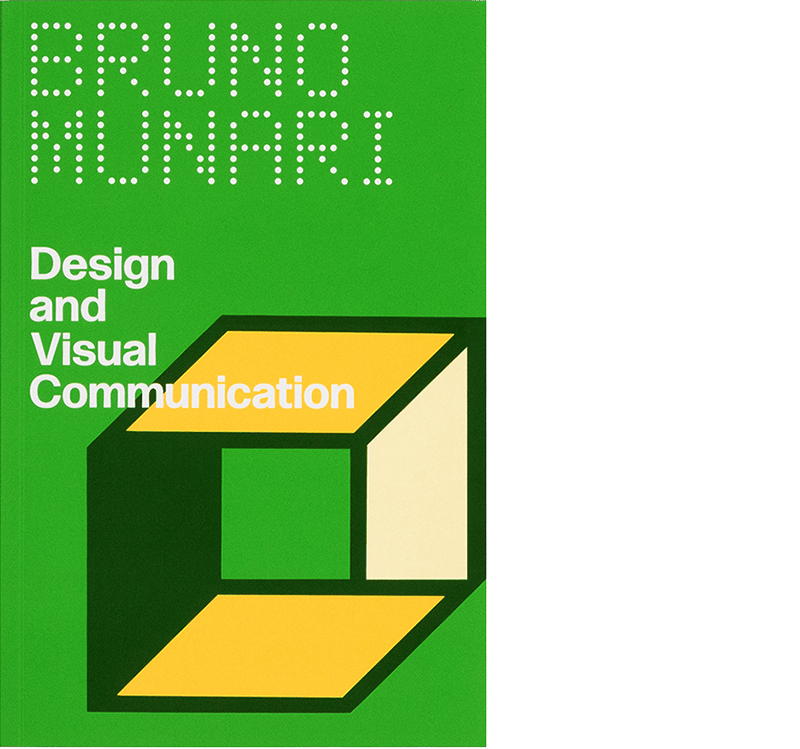
Design and Visual Communication
5.375 × 8.25 inches, 400 pages, softcover
ISBN 978-1-941753-71-2
Design by IN-FO.CO
Now shipping!
“Visual communication encompasses drawing, photography, three-dimensional modeling, and film; abstract and realistic forms, static and moving images, simple and complex ones as well. It extends to questions of visual perception such as the relationship between figure and ground, camouflage, moiré patterns, optical illusions, illusory motion, mirages, the persistence of vision, and afterimages. It includes every aspect of graphics, from the design of typographical fonts to newspaper page layouts, from exploration of the limits of word legibility to the techniques that facilitate the reading of texts. All these facets of visual communication share something in common: objectivity.”
—Bruno Munari
Design and Visual Communication—the first-ever English translation of Bruno Munari’s extraordinary Design e Comunicazione Visiva (1968)—remains an important guide to bridging design education and everyday life. Published after Munari served as visiting professor at Harvard’s Carpenter Center, Design and Visual Communication takes over fifty lessons, class materials, and even letters home in which he describes life in America, and transforms them into a book about the future of art, architecture, and design. Conceived as a living volume, the book was written as inspiration to current and future designers to push beyond the past, however recent, and develop new tools to see and understand tomorrow’s world.
The facsimile reprint is accompanied by new contextual annotations by Munari scholar and design historian Jeffrey Schnapp. These micro-interventions highlight the innovations that make this work as relevant today as when originally published.
$32.50 -

Fantasy
4.5 × 7 inches, 240 pages, softcover
ISBN 978-1-941753-70-5
Design by IN-FO.CO
“But isn’t imagination also fantasy? And can’t fantastic images also assume the form of sounds? Musicians speak of sonic images, sound objects. How does one invent a fish tale, an air-cooled engine, a new plastic?… fantasy, invention, creativity think; imagination sees.”
—Bruno Munari
Never-before translated into English, Bruno Munari’s Fantasy (Fantasia, 1977), invites the reader to explore their own imagination, creativity, and fantasy through a journey in Munari’s mind and work experience. His theory of creativity, developed in conversation with the Reggio Emilia approach and the work of Jean Piaget, foregrounds the book’s journey through Munari’s own design processes, and his work for clients and with children.
By turning life and work into a classroom, Munari unlocks a path through imagination in order to access his, and in turn our, deepest sense of play. The facsimile reprint is accompanied by new contextual annotations by Munari scholar and design historian Jeffrey Schnapp. These micro-interventions highlight the innovations that make this work as relevant today as when originally published.
$24.95 -

A *Co-* Program for Graphic Design
6 × 9 inches, 256 pages, softcover
ISBN 978-1-941753-72-9
Design by IN-FO.CO
Now shipping!
Event updates here: a-co-program-for-graphic-design.orgEvent updates here: https://a-co-program-for-graphic-design.org
“Over the years, David has shown me that design isn’t just about aesthetics or function—it’s about collaboration, experimentation, and constantly questioning what design can be. A *Co-* Program for Graphic Design is a fundamental exploration into the history of design, how it has shaped our society and reveals the often overlooked power that design holds in shaping our future.”
—Martine Syms, Artist and filmmaker
“'All together now,' as The Beatles sang in 1967. Those three simple words seem to be at the core of David Reinfurt’s argument, as he convincingly shows that graphic design, as a living practice, exists exactly in the intersection of multiplicity (‘All’), collectivity (‘Together’), and modernity (‘Now’).”
—Experimental Jetset, Graphic design studio
From ancient Rome to outer space, A *Co-* Program for Graphic Design features contributions by Danielle Aubert, Tauba Auerbach, Barbara Glauber, Shannon Harvey, Adam Michaels, Philip Ording, and Adam Pendleton. This collectively driven text expands David Reinfurt’s pragmatic and experimental approach to pedagogy into a collaborative project that weaves together a multiplicity of voices to present a polyphonic approach to design history and teaching.
This book extends Reinfurt’s highly acclaimed A *New* Program for Graphic Design to include material from three new Princeton University courses (Circulation, Multiplicity, and Research) expressly designed for online teaching.
These courses present a *co-*llaborative and *co-*operative way of telling and teaching design history, taking on subjects from the Detroit Printing Co-op, Corita Kent, and Charles and Ray Eames, to Marshall McLuhan, Sylvia Harris, and Virgil Abloh. Through a series of in-depth historical case studies and assignments that progressively build in complexity, the book serves as a practical guide to visually understanding the history—and shaping the future—of our designed world.
$29.95 -

A Queer Year of Love Letters | Alphabets Against Erasure
6 × 9 inches, 120 pages, softcover
ISBN 978-1-941753-79-8
Design by IN-FO.CO
Co-published by Inventory Press & Library Stack
ePub edition available via Library Stack
Now Shipping!
"This book skillfully and lovingly re-conceives of typography as a prime vessel for smuggling, as an instrument for remembering and imagining, and as both a time keeper and time traveler."
—Tauba Auerbach
"Yes, yes and more yes! This is the book everyone's mothers brothers cousins uncle and then some have been waiting for. It's all that and a bag of percolated barbecue truffle potato chips. If thats not enough, and you may think it isn't, one gets as a bonus the glorious G. B. Jones being interviewed in poetic depth–sublime."
—Vaginal Davis
"The word "erasure" makes me think of erasers. This book is a pencil. Write with it."
—Ellen Lupton
A Queer Year of Love Letters: Alphabets Against Erasure is a toolkit for writing and remembering queer and trans histories. Expanding on Nat Pyper’s series of fonts whose letterforms derive from the life stories and printed traces of countercultural queers of the last several decades, this new book showcases overlooked biographies alongside previously unseen archival materials, as well as Pyper’s unique approach to designing fonts as containers for memory.
The book debuts a new essay by Pyper, and includes contributions from Paul Soulellis, Claire Star Finch, Silas Munro, Lukaza Branfman-Verissimo, Rosen Eveleigh, and G. B. Jones that offer vital perspectives on queer archival practices, language lineages, design as protest, and love as the basis for research. Part reader, part type specimen, part love letter, these fonts foreground the politics of queer memory while opening up new avenues for writers, designers, and curious readers.
$24.95 -
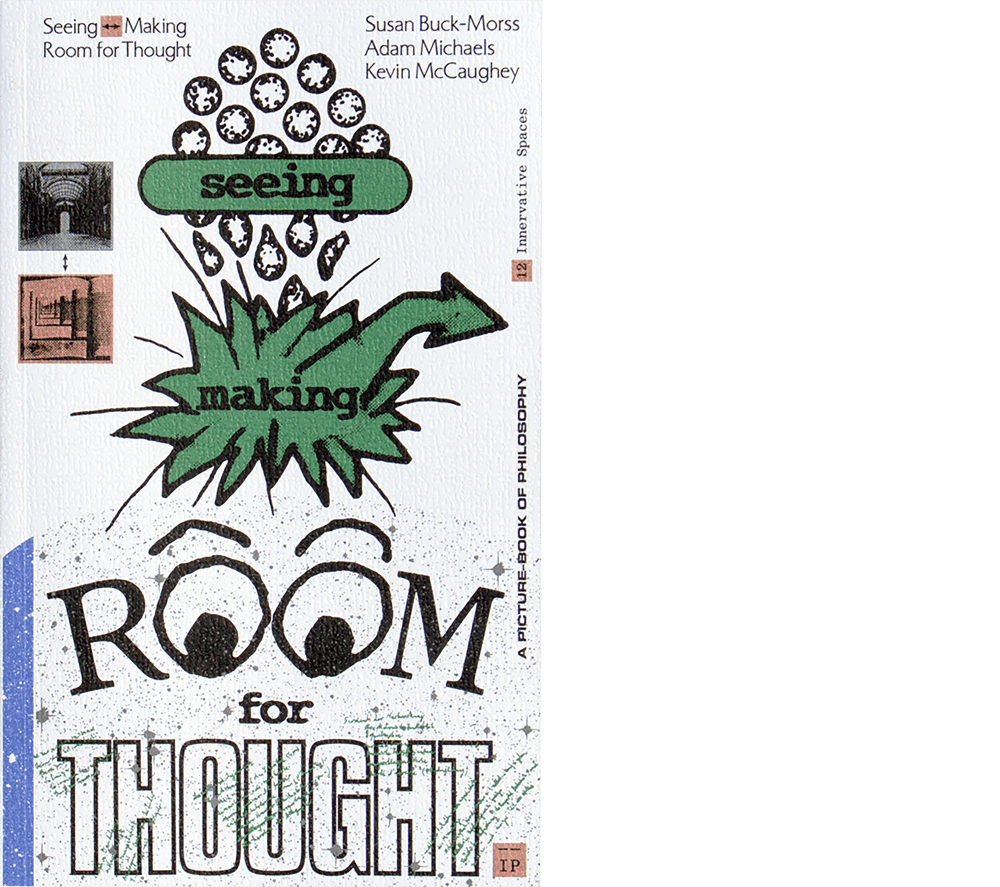
Seeing <—> Making | Room for Thought
4.75 × 7.75 inches, 400 pages, softcover
ISBN 978-1-941753-53-8
Design by IN-FO.CO and Kevin McCaughey
RE-PRINT SHIPPING JANUARY 2026
Pre-Order Now
For anyone who wants to think graphically about the image's role today, this exploding book of ideas is essential reading. —Rick Poyner
Seeing <—> Making: Room for Thought both studies and presents the creative process of constructing ideas with images. By activating the techniques of montage, the book reveals a wide field of view and a space to engage new critical connection between a multiplicity of objects from the past and present. Realized through an intergenerational collaboration of three cultural producers committed to making theory visible, a transformative anthology of critical essays by Susan Buck-Morss anchors this kaleidoscopic project. Images and ideas sync with Buck-Morss’ perceptive texts on visual culture, history, politics, and aesthetics, fusing criticism with visual play and linking collective imagination and social action.
Building upon the methods and ways of seeing put forth by visual thinkers like Walter Benjamin and John Berger, designer Kevin McCaughey (Boot Boyz Biz), designer, editor, and publisher Adam Michaels (IN-FO.CO/Inventory Press), and renowned theorist Buck-Morss collectively assemble colliding material into new relation. What results is a (typo-) graphic articulation that thinks seriously about the stakes of ideation and reorients the space of the book in the service of a theory and philosophy that speaks the language of our image-based information age.
$32.50 -

Clara Istlerová | A Life Among Letters
6 × 8.75 inches, 288 pages, softcover
ISBN 978-1-941753-80-4
Design by Anežka Minaříková and Marek Nedelka
Now shipping!
Clara Istlerová: A Life Among Letters is the first publication in the United States to delve into the design landscape of the former Czechoslovakia through the lens of Czech designer Clara Istlerová (born 1944). A trailblazer in her field, Istlerová was one of the few women in the male-dominated field of Czech typography. This publication introduces readers to Istlerová’s renowned book designs, particularly highlighting the analog processes she utilized to create one of the most influential books on Czech architecture, Švácha, Rostislav. From Modernity to Functionalism (Odeon, 1985).
The publication features an intimate interview with Istlerová conducted by editor Anežka Minaříková, accompanied by work from Istlerová’s personal archive alongside discussions detailing her creative process. Offering a vivid portrayal of an era where design was a tangible, labor-intensive endeavor carried out in close collaboration with typesetters and printers, the publication unveils the Czech design narrative of the twentieth century to English-speaking readers, highlighting Istlerová’s lasting impact and central role.
$35.00 -
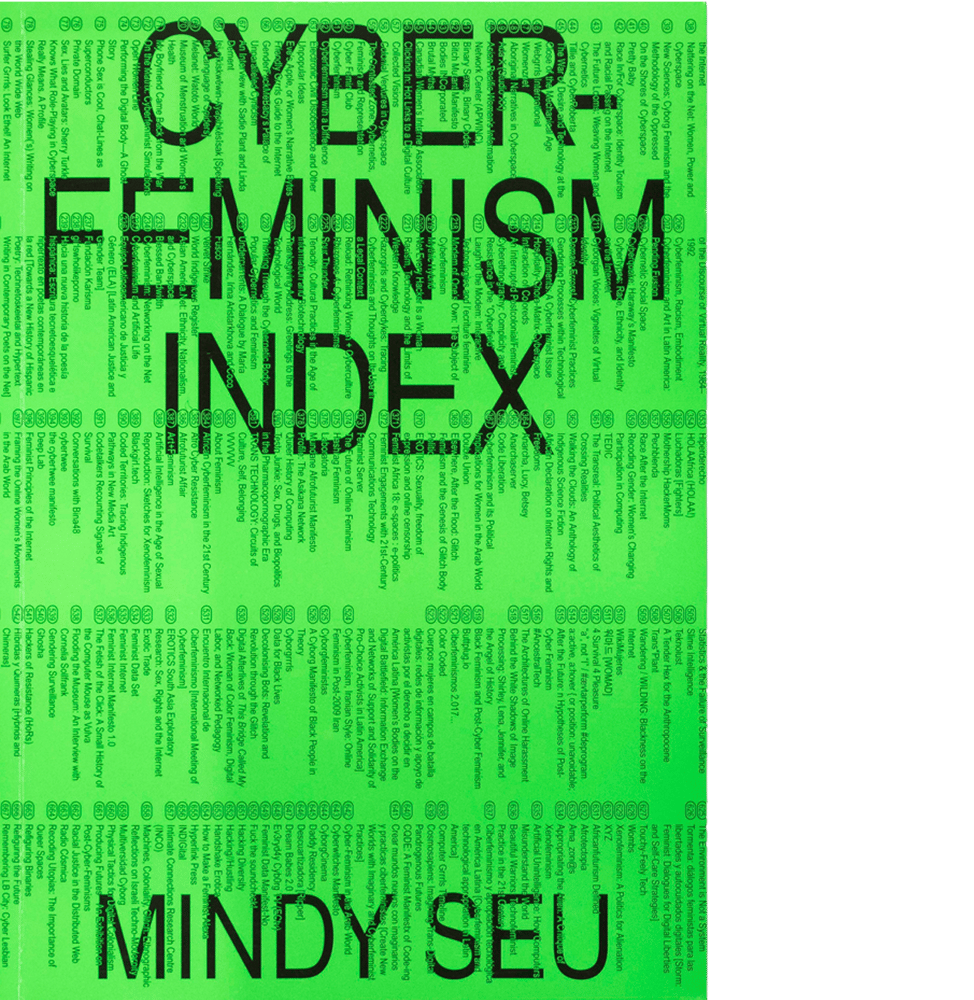
Cyberfeminism Index
6.75 × 9.5 inches, 608 pages
ISBN 978-1-941753-51-4
Design by Laura Coombs
“This invaluable research tool will hugely expand, update, and perhaps even revolutionize the feminist discourse. It might even be considered a work of conceptual art in itself."
—Lucy R. Lippard, author of Six Years: The Dematerialization of the Art Object from 1966 to 1972
“This book served as my doorway to cyberfeminism and I now see what an energetic continent awaits me. Anywhere I stepped it burned my hair off, it’s that brilliantly intense."
—Kevin Kelly, founding editor Wired magazine
In Cyberfeminism Index, hackers, scholars, artists, and activists of all regions, races and sexual orientations consider how humans might reconstruct themselves by way of technology. When learning about internet history, we are taught to focus on engineering, the military-industrial complex, and the grandfathers who created the architecture and protocol, but the internet is not only a network of cables, servers, and computers. It is an environment that shapes and is shaped by its inhabitants and their use.
The creation and use of the Cyberfeminism Index is a social and political act. It takes the name cyberfeminism as an umbrella, complicates it, and pushes it into plain sight. Edited by designer, professor, and researcher Mindy Seu, it includes more than 700 short entries of radical techno-critical activism in a variety of media, including excerpts from academic articles and scholarly texts; descriptions of hackerspaces, digital rights activist groups, and bio-hacktivism; and depictions of feminist net art and new media art.
Both a vital introduction for laypeople and a robust resource guide for educators, Cyberfeminism Index—an anti-canon, of sorts—celebrates the multiplicity of practices that fall under this imperfect categorization and makes visible cyberfeminism’s long-ignored origins and its expansive legacy.
“You can use it as a reference, follow a thread, or just access it at random and it delivers wit and wisdom from over three decades of one of the most politically and intellectually challenging movements of our era. What happens between sexed flesh and gendered tech? More than ever we all need to know."
—McKenzie Wark, author of A Hacker Manifesto
“This is an archive perfectly suited to its material: at ease with impermanence, richly appreciative of contradiction, and expansive in scope. Mindy Seu and her cohort of collaborators celebrate the polyrhythmic chorus of voices that have made cyberfeminist thought so delightfully difficult to define—and invite new, kaleidoscopic reinterpretations of our last three decades of life online."
—Claire L. Evans, author of Broad Band: The Untold Story of the Women Who Made the Internet
“The Cyberfeminism Index celebrates, troubles, and critiques the histories and futures of struggle against networked patriarchy—from its first libidinous eruptions to tenacious tactical disruptions and mutations. For theorists and hegemony hackers alike the Index offers an inspirational and educational resource for the urgent work of glitching and decolonizing intersectional internets now."
—Ruth Catlow, founder of Furtherfield
$39.95 -

A New *Program* for Graphic Design
Design by IN-FO.CO
Programming by O-R-G
A *New* Program for Graphic Design is a do-it-yourself textbook published by Inventory Press (Los Angeles) with DAP (New York) and designed by IN-FO.CO. The book synthesizes the pragmatic with the experimental and builds on mid-to late- 20th-century pedagogical models to convey advanced principles of contemporary design. Rooted in three courses (Typography, Gestalt, and Interface) originally developed for liberal arts students, David Reinfurt provides a broad and comprehensive introduction to graphic design and visual literacy for readers from any discipline.
The book was produced over three days in Los Angeles, based on eight years of teaching at Princeton University. One semester-long course was compressed and presented each day as six 45-minute lectures. These were recorded, transcribed, and edited with additional post-production.
The book has been distilled further into a simple screensaver software — A *New* Program for Graphic Design is now A New *Program* for Graphic Design.
*Upon purchase, you will receive an e-mail, containing a unique download code to redeem your software, as well as a physical artifact via mail.*
$25.00 -
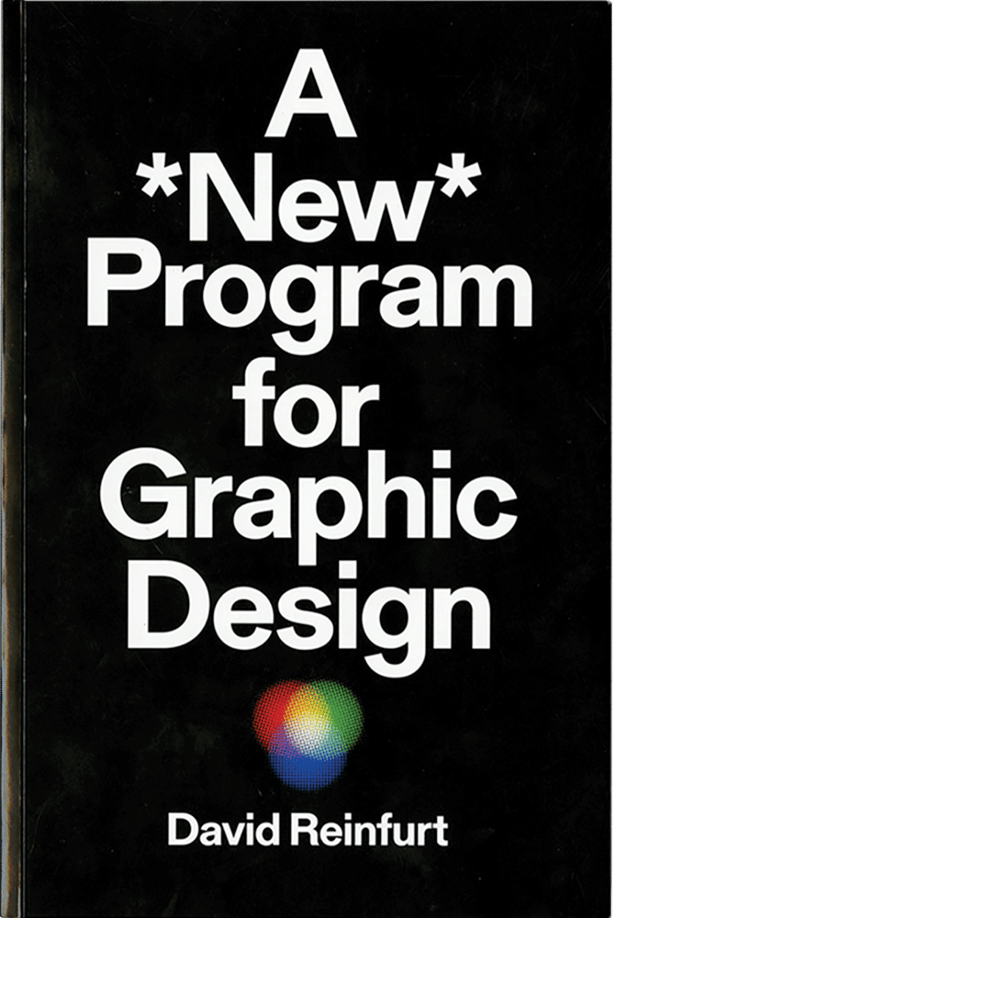
A *New* Program for Graphic Design
6 × 9 inches, 256 pages, softcover
ISBN 978-1-941753-21-7
Foreword by Adam Michaels
Introduction by Ellen Lupton
Design by IN-FO.CO
Co-published by
Distributed Art Publishers / D.A.P
ePub edition also available via O-R-G
and Apple Books and Kindle
Free teaching guide available here
“At a moment of tremendous technological and cultural change, David Reinfurt makes the case that graphic design is not merely a craft, but a fundamental way to understand and engage with the world. Discursive, expansive, and inspiring, this book redefines its subject and provides an indispensable guide to how it might be practiced.”
—Michael Bierut (Partner, Pentagram New York)
“David Reinfurt's new book provides … in-depth access to a historical analysis, exquisite close-focus portraits of multi-talented creative makers past and present, alongside his own research and examples of his class assignments. This intelligent book contains new insights regarding graphic design history, thought, and practice. This book is a reminder of Walt Whitman’s call for "a force infusion of intellect" to confront the future.”
—Sheila Levrant de Bretteville (Director, Yale University Graduate Program in Graphic Design)
A *New* Program for Graphic Design is the first Communication Design text book expressly of and for the 21st century. Synthesizing the pragmatic with the experimental, A *New* Program for Graphic Design builds upon mid- to late-20th-century pedagogical models to convey advanced principles in an understandable form for students of all levels.
David Reinfurt, a graphic designer, writer, and educator, has developed a design curriculum at Princeton University in which three courses provide a broad and comprehensive introduction to the field for students coming from a range of other disciplines. These courses—Typography, Gestalt, and Interface—are the foundation of this book.
Through a series of in-depth historical case studies and assignments that progressively build in complexity, the book serves as a practical guide to visually understanding and shaping the increasingly networked world of information and design.
David Reinfurt (born 1971), a graphic designer, writer and educator, reestablished the Typography Studio at Princeton University and introduced the study of graphic design. Previously, he held positions at Columbia University Graduate School of Architecture, Planning and Preservation, Rhode Island School of Design and Yale University School of Art. As a cofounder of O-R-G inc. (2000), Dexter Sinister (2006) and the Serving Library (2012), Reinfurt has been involved in several studios that have reimagined graphic design, publishing and archiving in the 21st century. He was the lead designer for the New York City MTA Metrocard vending machine interface, still in use today. His work is included in the collections of the Walker Art Center, Whitney Museum of American Art, Cooper Hewitt National Design Museum and the Museum of Modern Art. He is the co-author of Muriel Cooper (MIT Press, 2017), a book about the pioneering designer.
A free PDF teaching guide is available as a resource for using the book in an introductory graphic design class, geared for students with no previous background in the subject.
$25.00 -
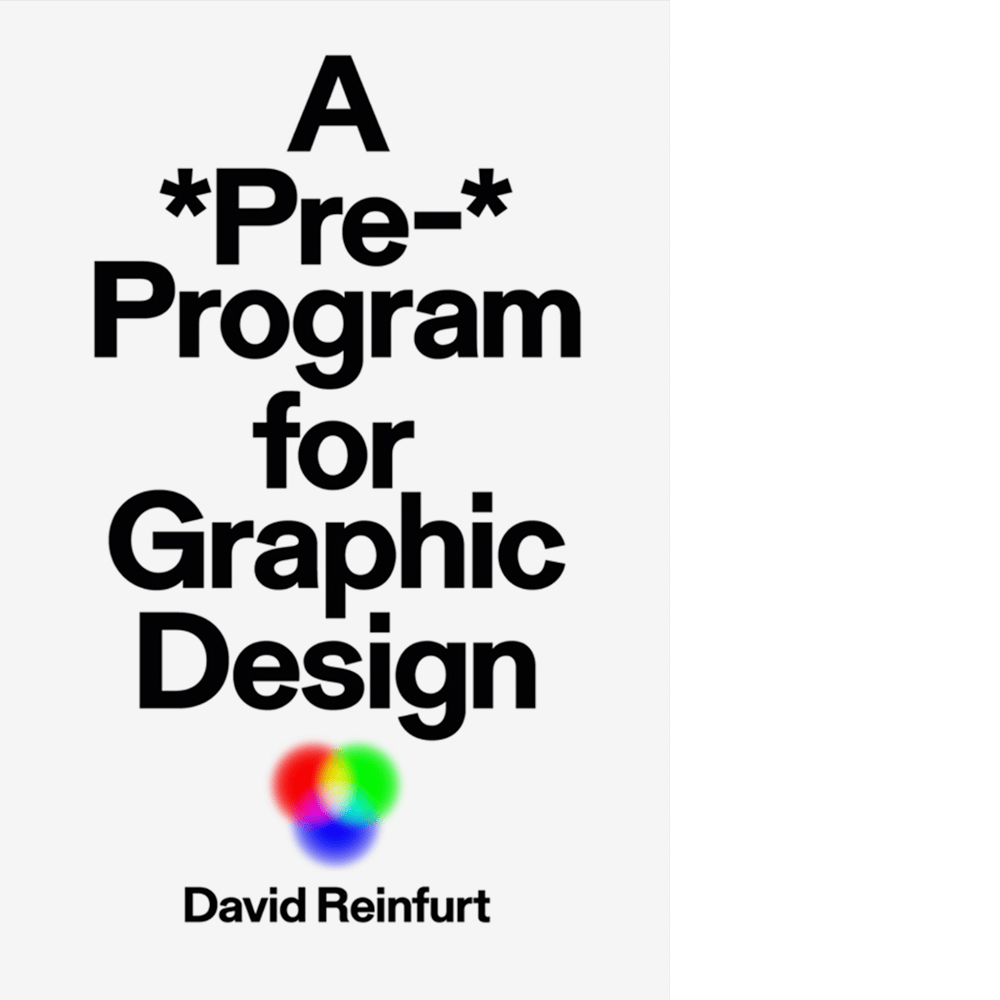
A *Pre-* Program for Graphic Design
ePub
ISBN 978-1-941753-42-2
Not available via inventorypress.com
Order now via O-R-GA *New* Program for Graphic Design, a DIY textbook that synthesizes the pragmatic with the experimental to convey advanced graphic design principles in an understandable form for students of all levels as well as general readers.
Based on courses originally developed for liberal arts students at Princeton University, the book was derived from a three-day lecture series held in Los Angeles, delivered to a live studio audience and video recorded. The result is a broad introduction to graphic design and visual literacy, covering a wide range of topics, from Benjamin Franklin to Bruno Munari, Moholy-Nagy to Muriel Cooper and the Macintosh computer.
This ePub contains 18 instructional videos, 6 for each of the book’s three sections: T-Y-P-O-G-R-A-P-H-Y, G-E-S-T-A-L-T, and I-N-T-E-R-F-A-C-E.
A *Pre-* Program for Graphic Design can serve as a teaching tool, and can be used either in combination with A *New* Program for Graphic Design, or on its own.
$0.01
Sold Out -

Border Tuner
7.5 × 10 inches, 304 pages, softcover
ISBN 978-1-941753-88-0
Design by IN-FO.CO
Published by Inventory Press
Available for Pre-order
Shipping March 2026
This volume critically documents, contextualizes, and theoretically elaborates the ongoing resonance of artist Rafael Lozano-Hemmer’s work Border Tuner | Sintonizador Fronterizo (2019). A large-scale, participatory art installation composed of powerful searchlights forming “bridges of light” that opened live channels for direct communication across the U.S.-Mexico border, the project forged a platform for a wide-range of local voices between El Paso, Texas and Ciudad Juárez, Chihuahua at a time of fraught border rhetoric, militarized surveillance, and nationalist violence. In opposition to the modes of control and the regulation of bodies profusely developed along the border line, Lozano-Hemmer proposed a momentary alternative. Border Tuner | Sintonizador Fronterizo made visible and audible the existing relations, interdependence, and co-existence between the two cities that create the largest binational metropolitan area in the Western Hemisphere. To this extent, it is a critically important artistic work that strove to cultivate relations beyond the limits and perpetual violence of the nation-state.
The edition’s twelve essays – composed by a range of historians, theorists, curators, artists, and cultural workers – enter into convivial exchange with the voices and language, bodies and performances of those who activated Border Tuner | Sintonizador Fronterizo. In various turns, the writings contextualize the work, its installation, and its utilization before moving onto a wider-scale assessment of its geopolitical site and moment. Following this, the trajectory of the essays turns to focus on previous instantiations of Lozano-Hemmer’s artistic experimentations with light and shadow, communicational infrastructures, and the varying cultural-political specificities of their assembly. From this constellation, the essays then examine the art at the border line and in the borderlands, more generally. Here, the writings critically assess the project through several perspectives, such as Indigenous sovereignty and its relation to nation-states, modes of outsider extractivism within the frame of local cultural production, within the art historical context of border arts more generally, as well as in relation to the cultural-technological avant-gardes of earlier generations in Mexico, and through the frame of the state’s militarized structures of surveillance in the region. Finally, the edition turns to consider the legacy of Border Tuner | Sintonizador Fronterizo, though not by focusing on the significance of the work itself, but by thinking with the resonance of the actions of its production, the voices of its platforms, the discursive breakthroughs of its forums, and the material infrastructure it established to support border arts practices.
$45.00 -
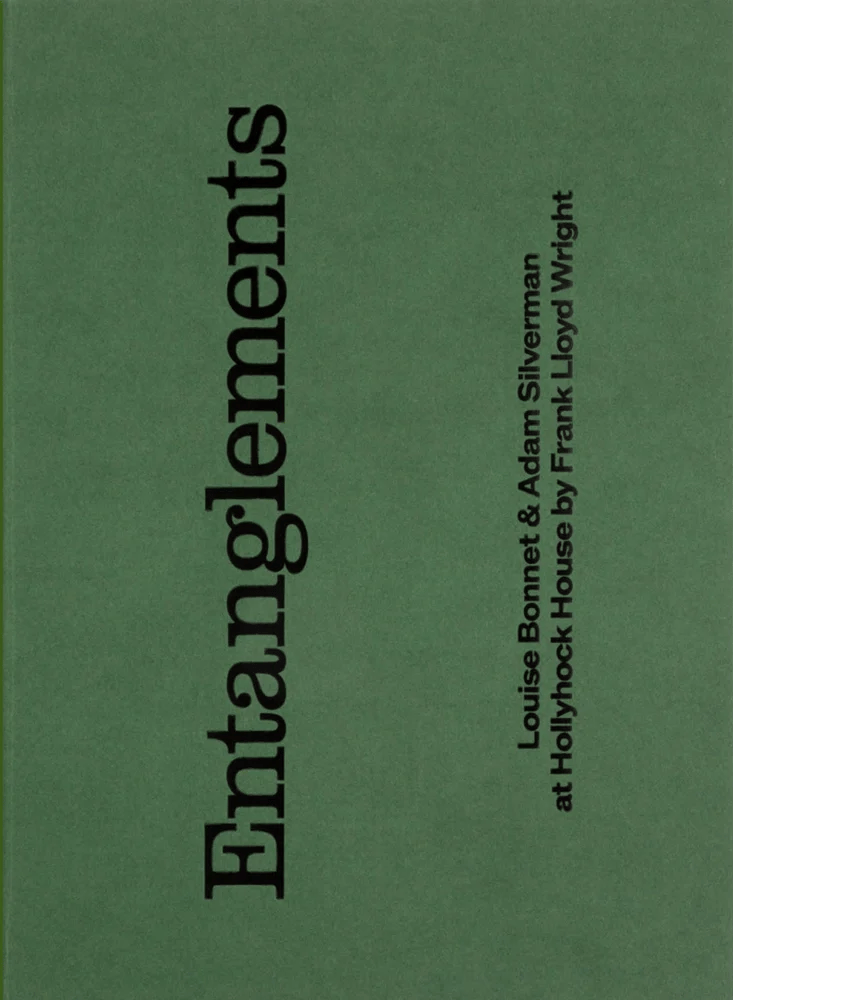
Entanglements
12.5 x 8.75 inches, 96 pages, hardcover
ISBN 978-1-941753-64-4
Design by IN-FO.CO
Co-published by Inventory Press and Galerie Max Hetzler
Entanglements: Louise Bonnet and Adam Silverman at Hollyhock House weaves together documentation of new works by Louise Bonnet and Adam Silverman with conversations by artists, architects, chefs, and friends whose work and lives are entangled in Los Angeles. Made in response to and installed at Frank Lloyd Wright’s Hollyhock House, Bonnet’s paintings and drawing and Silverman’s ceramics engage the house’s hundred-year history as a platform for artists and experimentation. The centerpiece of an arts park, Hollyhock House was only partially realized by Wright and completed by others, and has served as a home, an arts center, a social club, and a house museum. The exhibition foregrounds the many entanglements of place, broadening perspectives on this California house and its layered history. By placing conversations and reflections in dialogue with photo documentation by Joshua White, the book is a meditation on being intertwined.
Photographs by Joshua White and essay by Abbey Chamberlain Brach. With contributions by Isabelle Albuquerque & Jon Ray; Vinny Dotolo & Jon Shook; Shannon Harvey & Adam Michaels; Michael Maltzan & Amy Murphy; Hardy Ophuls & Sarah Watson; Rob Reynolds & Mary Wigmore; Joe Sola & Erin Wright; and Ricky Swallow & Lesley Vance.
$55.00 -
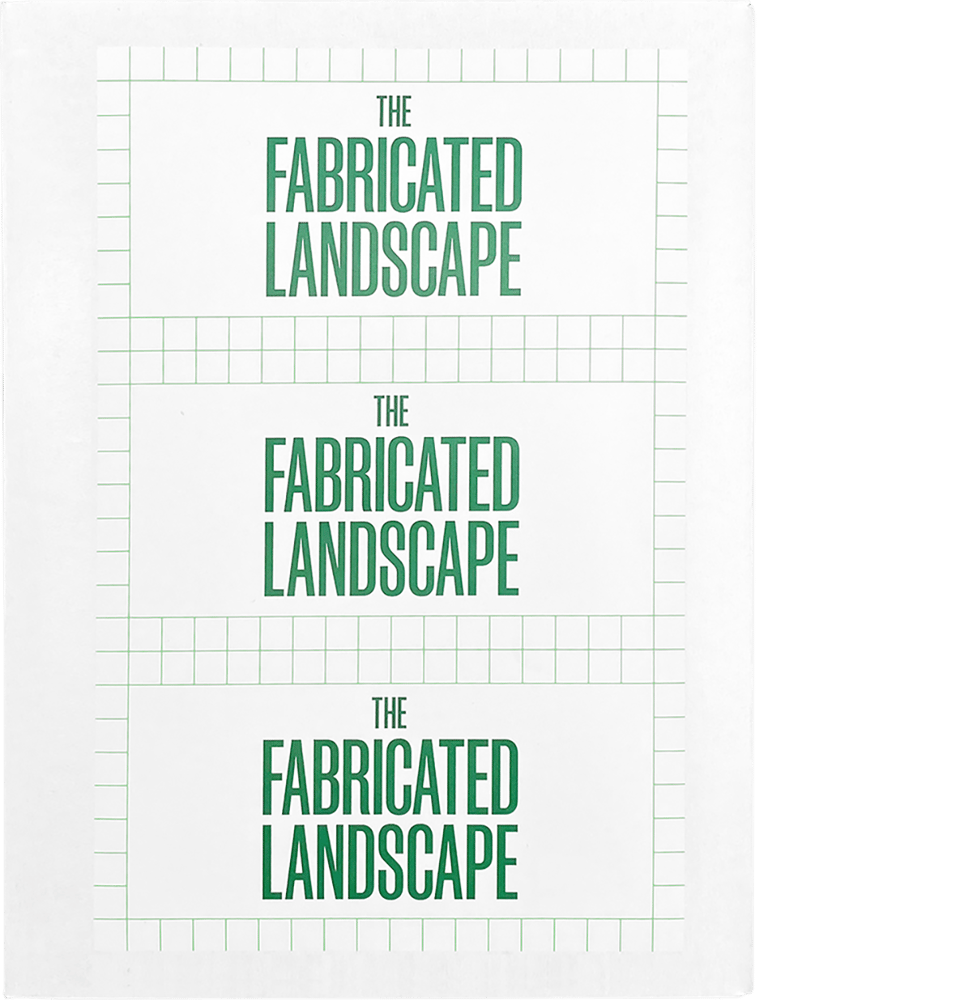
The Fabricated Landscape—Domestic, Civic, and Territorial
Envelope containing three
saddle-stitched books
Domestic: 6 × 9 inches, 64 pages
Civic: 12 × 9 inches, 32 pages
Territorial: 12 × 18 inches, 16 pages
Design by IN-FO.COCo-published by Inventory Press
and Carnegie Museum of Art
The Fabricated Landscape (June 26, 2021–January 17, 2022, Heinz Architectural Center, Carnegie Museum of Art) presents projects from ten contemporary international architectural practices that are exceptionally responsive to the communities, localities, and cultures in which they are situated.
This exhibition catalogue, organized by scale, and presented in three parts, features extensive documentation of projects by Anna Heringer, Anne Holtrop, Assemble, Frida Escobedo, Go Hasegawa, LCLA office, MAIO, OFFICE Kersten Geers David Van Severen, SO-IL, and UMWELT alongside texts from curator Raymund Ryan, Emilio Ambasz, Emanuele Coccia, Jing Liu, and more.
Based on a continuous grid system, the publication’s three volumes are packaged in a 6 × 9 inch folder, but fold out to dramatically varied page sizes: 6 × 9 inches, 12 × 9 inches, and 12 × 18 inches.
$20.00
Sold Out -
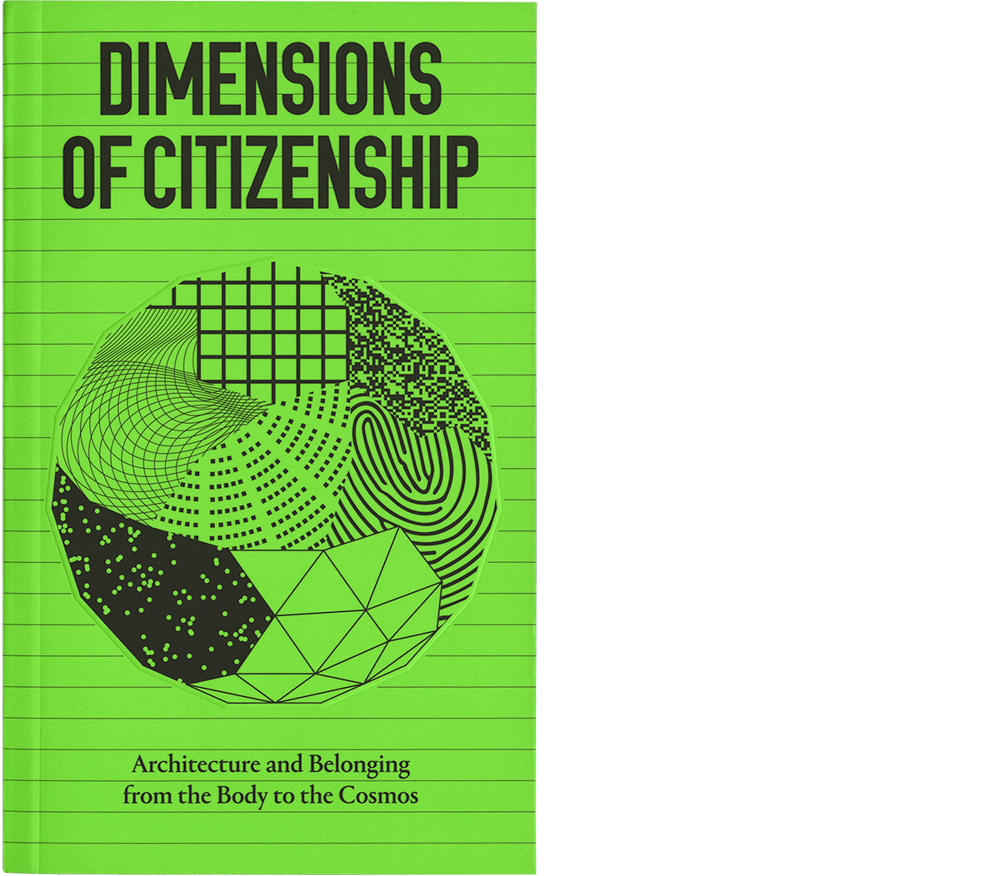
Dimensions of Citizenship
Edited by Nick Axel, Nikolaus Hirsch, Ann Lui, and Mimi Zeiger
4 1/4 × 7 inches, 256 pages, softcover
ISBN 978-1-941753-19-4
Design by IN-FO.CO
Seven unique covers available!
Globalization, technology, and politics have altered the definition and expectations of citizenship and the right to place. Dimensions of Citizenship documents contributions from the seven firms selected to represent the United States in the 2018 Venice Architecture Biennale. This paperback volume profiles and illustrates each of the US Pavilion contributions and contextualizes them in terms of scale.
Drawing inspiration from the Eames’ Power of Ten, Dimensions of Citizenship will provide a view of belonging across seven stages starting with the individual (Citizen), then the collective (Civic, Region, Nation), and expanding to include all phases of contemporary society, real and projected (Globe, Network, Cosmos). Additional essays—by Ingrid Burrington, Ana María León, and Nicholas de Monchaux, among others—will offer essential and enquiring responses to these themes.
From “social to speculative; technical to theoretical,” the participating teams lead intellectual and architectural practices that not only situate the US as a leading center of critical research at the heart of the debate on citizenship, social conscience, and a just society, but also as a place at the intersection of political action, public policy, and changing notions of nationality.
Participants in the US Pavilion at the 2018 Venice Architecture Biennale are: Amanda Williams & Andres L. Hernandez with Shani Crowe (Chicago, IL); Design Earth (Cambridge, MA); Diller Scofidio + Renfro, Laura Kurgan, Robert Gerard Pietrusko with Columbia Center for Spatial Research (New York, NY); Estudio Teddy Cruz + Fonna Forman (San Diego, CA); Keller Easterling (New Haven, CT); SCAPE (New York, NY); and Studio Gang (Chicago, IL). The exhibition is curated by Niall Atkinson, Ann Lui, and Mimi Zeiger; and commissioned by the School of the Art Institute Chicago and University of Chicago.
$25.00
Sold Out -
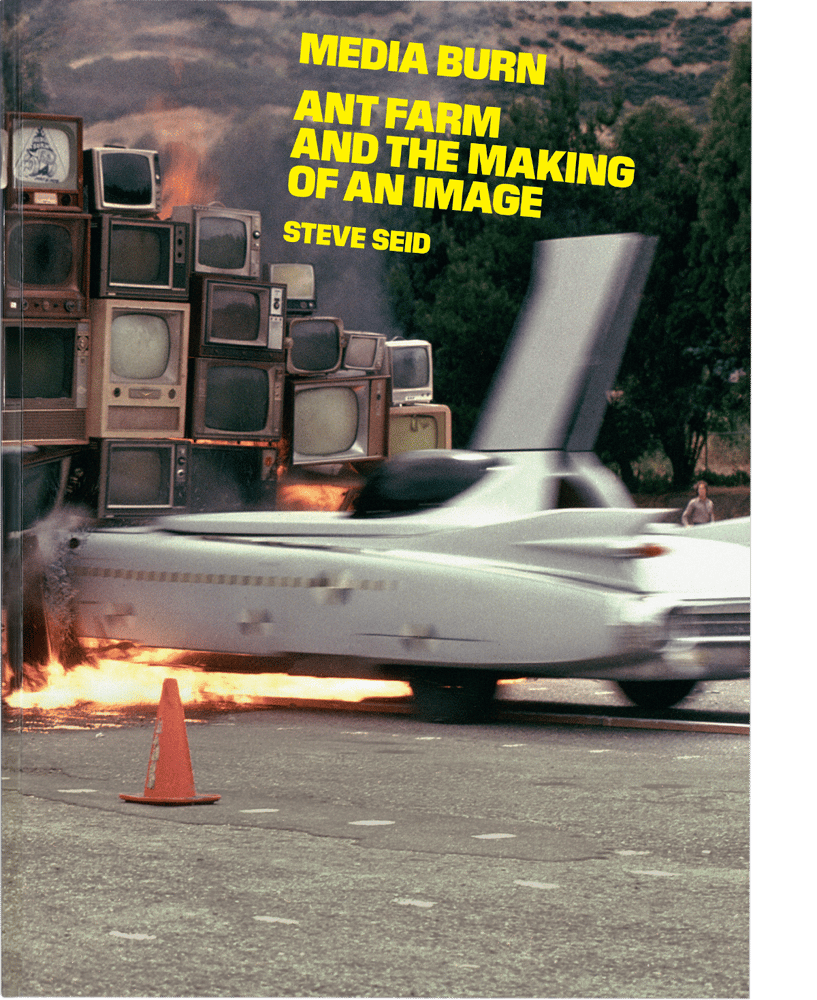
Media Burn—Ant Farm and the Making of an Image
9 x 12 inches, 128 pages, softcover
ISBN 978-1-941753-35-4
Introduction by Chip LordDesign by IN-FO.CO Co-published by Inventory Press
and RITE Editions
Ant Farm, the conceptual architectural practice turned art collaborative, is known for such distinctive works as House of the Century (1971–73), Cadillac Ranch (1974), and The Eternal Frame (1975).
Of equal notoriety is Media Burn, Ant Farm’s legendary 1975 performance, in which a radically customized Cadillac was driven through a wall of burning television sets. Media Burn: Ant Farm and the Making of an Image is a vibrant assessment of the complex set of cultural references and art-making strategies informing this collision of twentieth-century icons.
Author Steve Seid (Berkeley Art Museum and Pacific Film Archive) probes the little-known critical backstory of this bold performance (and resulting video work) and its irreverent effort to mount a subversive critique of media hegemony while reimagining the core meaning of performance itself.
Media Burn: Ant Farm and the Making of an Image examines car culture, image proliferation, and radical architectural practice, and offers a close read of Media Burn’s numerous texts, speeches, ephemera, and artifacts.
$35.00 -
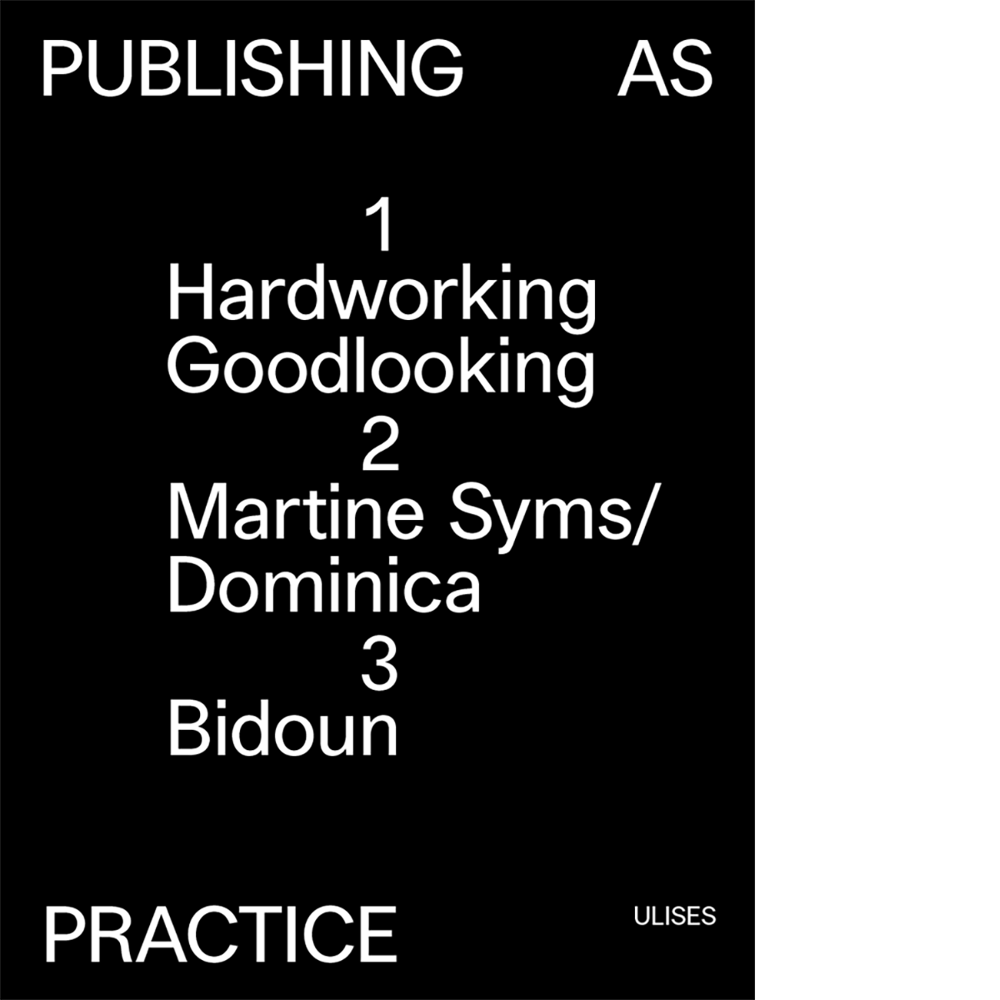
Publishing as Practice
7 ¾ × 10 inches, 176 pages
ISBN 978-1-941753-40-8
Design by Joel Evey and David WiseCo-published by Inventory Press & Ulises
Publishing as Practice: Hardworking Goodlooking, Martine Syms/Dominica, Bidoun centers on the work of three contemporary artists/book publishers who have developed fresh ways of broaching the political in publishing.
This book documents a residency program at Ulises—a curatorial platform based in Philadelphia—that explores publishing as an incubator for new forms of editorial, curatorial and artistic practice. Over the course of two years, three participants (Hardworking Goodlooking, Martine Syms/Dominica, and Bidoun) activated Ulises as an exhibition space and public programming hub, engaging the public through workshops, discussions, and projects.
Hardworking Goodlooking is a design and publishing imprint working primarily out of the Philippines. Dominica is an imprint run by artist Martine Syms dedicated to exploring Blackness as a topic, reference, marker, and audience in visual culture. Bidoun, a non-profit organization and magazine, focuses on art and culture from the Middle East and its diasporas. Each organization approached their residency at Ulises in a unique way, bringing a new understanding of what it means to practice publishing.
Edited by Kayla Romberger, Gee Wesley, Nerissa Cooney, Lauren Downing, and Ricky Yanas, Publishing as Practice features a preface by David Senior, Head of Library and Archives at the San Francisco Museum of Modern Art, and Ulises Carrión’s 1975 publishing manifesto “The New Art of Making Books.” Publishing as Practice also includes writing from Clara Balaguer, Hardworking Goodlooking, Martine Syms/Dominica, Bidoun, Lauren Downing, Kayla Romberger, and Gee Wesley alongside interviews, excerpts, and documentation from each residency.
$35.00
Sold Out -
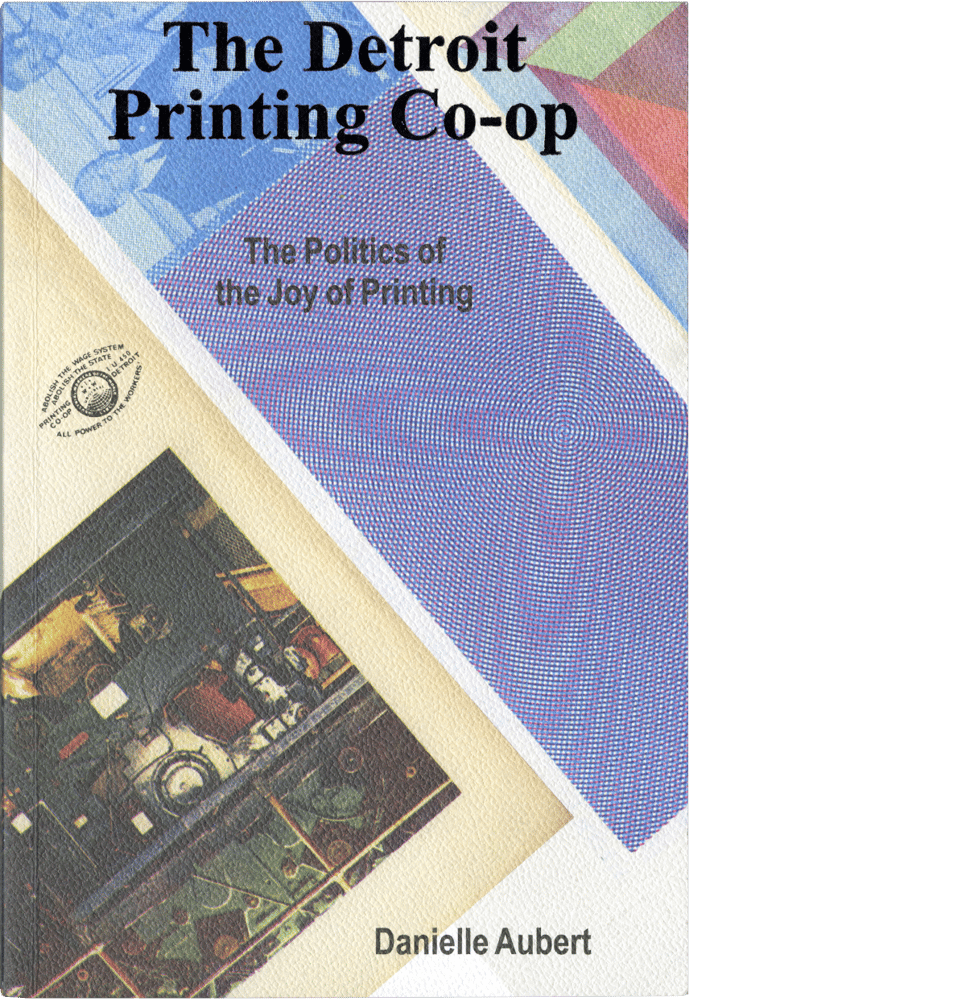
The Detroit Printing Co-op
6 1/2 × 9 1/2, 240 pages, softcover
ISBN 978-1-941753-25-5
Design by Danielle AubertEpub now available for purchase here
Download Danielle Aubert's introduction here
“Danielle Aubert’s history of the Detroit Printing Co-op offers a refreshing example of graphic design as it was practiced in the most alternative of ways—not only outside of the mainstream design profession, but also against the prevailing capitalist economy premised on private ownership. For enthusiasts of graphic design, Fredy Perlman’s unexpected visually inventive designs for politically salient works offer a much needed example of how self-publishing and DIY printing, so in vogue today, can be used to not just make something, but to also say something.” —Andrew Blauvelt, Director, Cranbrook Museum of Art
In 1969, shortly after moving to Detroit, Lorraine and Fredy Perlman and a group of kindred spirits purchased a printing press from a defunct militant printer and the Detroit Printing Co-op was born. The Co-op would print the first English translation of Guy Debord’s Society of the Spectacle and journals like Radical America, formed by the Students for a Democratic Society; books such as The Political Thought of James Forman printed by the League of Revolutionary Black Workers; and the occasional broadsheet, such as Judy Campbell’s stirring indictment, “Open letter from ‘white bitch’ to the black youths who beat up on me and my friend.”
Fredy Perlman was not a printer or a designer by training, but was deeply engaged in ideas, issues, processes, and the materiality of printing. His exploration of overprinting, collage techniques, varied paper stocks, and other experiments underscores the pride of craft behind these calls to action and class consciousness.
Building on in-depth research conducted by Danielle Aubert, a Detroit-based designer, educator, and the author of Thank you for the view, Mr. Mies, this book explores the history, output and legacy of the Perlmans and the Co-op in a highly illustrated testament to the power of printing, publishing, design, and distribution.
$29.95
Sold Out -
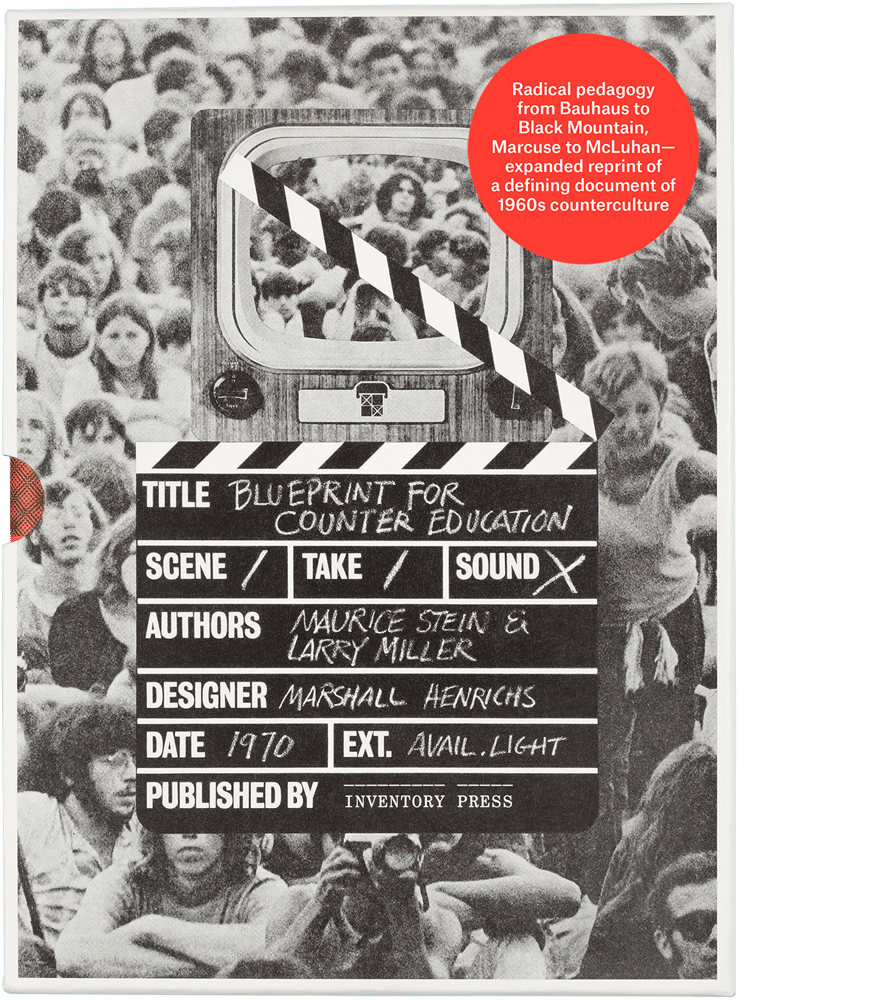
Blueprint for Counter Education
7 7/8 × 10 5/8 inch slipcase containing
two 7 5/8 × 10 1/8 inch softcover books
and three 45 × 37 1/4 inch posters
ISBN 978-1-941753-09-5
Design by Marshall Henrichs (original materials)
and Project Projects (new materials)"Perhaps one of the most extraordinary books ever issued by an American commercial publisher.” —Richard Kostelanetz
Blueprint for Counter Education is one of the defining (but neglected) works of radical pedagogy of the Vietnam War era. Originally published in 1970 and integrated into the design of the Critical Studies curriculum at CalArts, the book was accompanied by large graphic posters that could serve as a portable learning environment for a new process-based model of education, and a bibliography and checklist that map patterns and relationships between radical thought and artistic practices—from the avant-gardes to postmodernism—with Marcuse and McLuhan serving as points of anchorage. Accompanying this new facsimile edition of the book, posters, and slipcase is a 80-page book featuring a conversation with the original Blueprint authors Maurice Stein, Larry Miller, and designer Marshall Henrichs, as well as essays from Jeffrey Schnapp, Paul Cronin, and notes on the design by Adam Michaels of Project Projects.
$55.00 -

49 Cities
9 1/4 × 9 1/4 inches, 160 pages, hardcover
ISBN 978-1-941753-05-7
Design by Project Projects
Expanded third edition
“49 Cities has been a point of reference for me... and it has had a significant impact on my thinking. It presents the city as a properly architectural problem.”—Stan Allen, architect
Throughout history architects and planners have dreamed of “better” and different cities—more controllable, more defensible, more efficient, more monumental, more organic, taller, denser, sparser or greener. With every plan, radical visions were proposed, ones that embodied not only the desires but also, and more often, the fears and anxieties of their time. Today, with the failure of the suburban experiment and the looming end-of-the world predictions—from global warming and waste to post-peak oil energy crises and uncontrolled world urbanization—architects and urbanists find themselves once more at a crossroad, fertile for visionary thinking.
49 Cities is a call to re-engage cities as the site of radical thinking and experimentation, moving beyond “green building” toward an embrace of ideas, scale, vision and common sense combined with delirious imagination in the pursuit of empowering questioning and re-invention.
In addition to enhanced, high-quality reproductions and illustrations, this cloth-bound third edition includes an interview between Amale Andraos, Dan Wood, Joseph Grima, and Archigram’s Michael Webb, an essay on The Death and Life of Urban Planning by Sam Jacob (founder of FAT Architecture) and new interviews with culture-defining architects Chip Lord (Ant Farm) and Yona Friedman.
$36.00 -

Catalogue
10 × 13 inches, 320 pages, softcover
ISBN 978-1-941753-03-3
Design by Project Projects
Catalogue suggests an artist’s exhibition catalogue, but is rather a chronological compilation of auction catalogues presenting the sales of the mid-century furniture designed by Le Corbusier and Pierre Jeanneret for Chandigarh, India, featured in Amie Siegel’s multi-element film installation Provenance (2013). An aside, an addendum, an index, the publication ends with the Christie's London catalogue page from the 2013 auction of Provenance itself in the Post-War and Contemporary Art Sale, which completes the economic circuit of the project.
American artist Amie Siegel’s work has been exhibited in solo and group exhibitions at the Metropolitan Museum of Art, New York MoMA/PS1, NY; Hayward Gallery, London; Whitney Museum of American Art, NY; Walker Art Center, MN; CCA Wattis, San Francisco; Kunstmuseum Stuttgart; Kunst-Werke, Berlin, Cannes Film Festival and Berlin Film festival among many others. She has been a fellow of the DAAD Berliner-Künstlerprogramm, Guggenheim Foundation, and the recipient of a Sundance Institute Film Fund award.
$150.00
Sold Out -
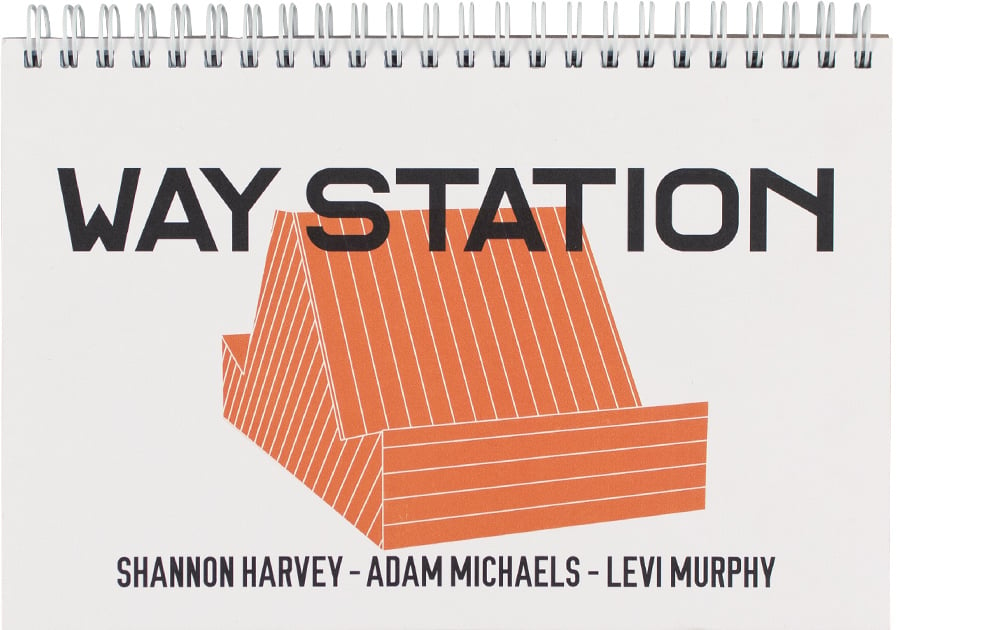
Way Station
8 1/4 × 5 1/2 inches, 50 pages, wirebound
ISBN 978-1-941753-08-8
Edition of 100 numbered copies
Way Station extends the January 2015 exhibition by Shannon Harvey, Adam Michaels, and Levi Murphy at Grice Bench, Los Angeles. At once static and dynamic, the book presents a journey through a series of landscapes, juxtaposed with a steadily spinning furniture form—that of the primary exhibition component, a set of colorful benches featuring ergonomics designed to heighten and transform physical and mental awareness. The book provides a particularly associative experience for a reader seated on a Way Station bench, while maintaining interest far beyond this setting. Shannon Harvey is a designer and colorist. Adam Michaels is the cofounder of design studio Project Projects, and founder of Inventory Press. Levi Murphy is a designer and founder of Communal Objects.
$20.00
Sold Out -

The Electric Information Age Book: McLuhan/Agel/Fiore and the Experimental Paperback
4 1/4 x 7 inches, 240 pages, softcover
ISBN 978-1-61689-034-6
Design by Project Projects
Inventory Books paperback series IB03, copublished by Princeton Architectural Press
Free poster included
The Electric Information Age Book explores a time span in mass-market publishing in the sixties and seventies when former backstage players—designers, graphic artists, editors, "coordinators," and "producers"—stepped into the spotlight to create a set of exceptional paperback books.
The period begins in 1966 when Jerome Agel and Quentin Fiore, in collaboration with Marshall McLuhan, first developed The Medium Is the Massage into “an inventory of effects,” and continues to 1975, the publication year of Other Worlds, Agel’s collaboration with the exobiologist Carl Sagan. Graphic designers such as Fiore employed a variety of radical techniques—verbal visual collages and other typographic pyrotechnics—that were as important to the content as the text.
Aimed squarely at the young media-savvy consumers of the “Electric Information Age,” these small, inexpensive paperbacks brought the ideas of contemporary thinkers to the masses and established a distinctive new graphics-rich, montage-based genre of bookmaking that still resonates loudly today.
$22.95
Sold Out -

Essays
5.5 × 9.5 inches, 392 pages, softcover
ISBN 978-1-941753-99-6
Design by Ninotchka RegetsAvailable for Pre-order
Shipping April 2026
In this comprehensive survey of his writing to date, Joe Day examines the intersections of architecture, contemporary art and urbanism as interdependent visual and spatial disciplines. Including pieces for both academic and general readership, letters, reviews, public addresses and responses, Essays offers a full account of Day’s thirty-year critical development, and a revealing look at L.A.’s built environment and intellectual climate at the turn of the millennium. Organized in three chronological sequences—“Transgressions,” “Situations” and “Reactions”—this collection begins with nominalist observations on art and architecture, turns then to writing on cities, and concludes with responses to major works and figures including Frank Gehry, Peter Eisenman, Mike Davis and Rosalind Kraus, as well as many more recent protagonists.
Essays joins Day’s previous monographs, Arrays (SCI-Arc, 2016) and Forays (ORO, 2021), which gather his prolific diagraming and design work, respectively. His earlier book, Corrections & Collections: Architectures for Art and Crime (Routledge, 2013), explores the evolving polarities in contemporary exhibition and incarceration.
$28.00